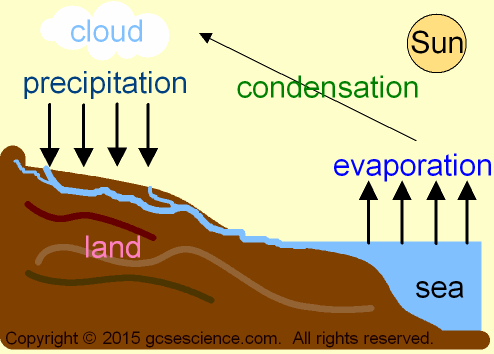
gcsescience.com 1 gcsescience.com
Water, Carbon and Nitrogen Cycles
The Water Cycle.
What is the Water Cycle?
The water cycle
describes the movement of water
through the environment. Water evaporates from the
surface of the sea
and moves up into
the atmosphere.
Water leaves the atmosphere and
falls back into
the sea or falls on to land where
some water flows back
into the sea as a river
as shown in the picture below.
Some water remains on land
either in lakes or reservoirs
or the water becomes frozen
and exists as ice or snow.

How does the Water Cycle work?
The water cycle
works because of heat
from the Sun.
Water
evaporates from the surface of
the sea as warm air
moves across
it. Secondary sources (less important)
of water
vapour in the air
are volcanoes and
animal respiration.
Water vapour in the air condenses into small droplets,
and these droplets form clouds. Water
falls from the clouds
onto
land, as rain or snow. This is called precipitation.
Water
on the land collects in streams,
rivers and lakes,
and flows back to the sea, completing the
cycle.
Why is the Sea Salty?
Rain
and river water erodes rocks, dissolving
some of
the material as salts. This is what makes the sea salty.
The composition of the sea today is a balance
between
the amount of salt entering the
sea from
weathering of
rocks
and the removal of dissolved salts by
crystallisation
(forming rock salt),
shell formation
by
sea creatures
and chemical reactions forming sediments.
![]() Links
The Atmosphere
Revision Questions
Links
The Atmosphere
Revision Questions
![]()
gcsescience.com The Periodic Table Index Water Cycle Quiz gcsescience.com
Home GCSE Chemistry GCSE Physics
Copyright © 2015 gcsescience.com. All Rights Reserved.